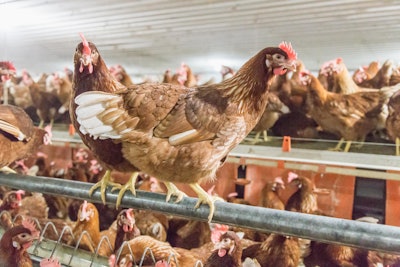
Factors found to be associated with an increased risk of highly pathogenic avian influenza (HPAI) infection on egg farms include being located in an existing control zone, having sightings of wild waterfowl, mowing vegetation on the premises less than four times a month, maintaining an off-site daily mortality disposal process and having wild bird access to feed or feed ingredients, according to a study conducted by led by the U.S. Department of Agriculture (USDA) Animal and Plant Health Inspection Service (APHIS).
Disease-free farms near an infected farm must be extremely committed to their biosecurity practices to prevent infection no matter the source of spread, explained Dr. Alice Green, USDA Veterinary Epidemiologist and lead researcher on the study, during the 2023 International Avian Influenza Summit.
The study also identified factors that could help egg producers prevent HPAI. These factors included a high frequency of vehicle washing for trucks and trailers entering the farm (ideally with a permanent wash station), having designated personnel assigned to each barn, having a specific farm entrance gate and requiring workers entering poultry barns to change clothes.
According to the researchers, gates help improve the control of traffic onto farms and could increase the chances that visitors see signage and follow the requested biosecurity practices.
Commercial table egg farms in the U.S. comprised the highest percentage of affected commercial poultry in the 2022 HPAI outbreak, explained Green.
“For context, over 75% of affected commercial poultry were a part of the commercial table egg production sector,” said Green. “For greater context, in 2022 alone, over 57 million commercial and backyard poultry in 47 U.S. states were affected by HPAI.”
More about the study
The study was conducted between February and September 2022 and included 18 farms in eight states comprising Delaware, Iowa, Maryland, Minnesota, Nebraska, Ohio, Pennsylvania and Utah.
Green said over 80% of table egg producers affected with HPAI in these participating states joined the study, showing testament to the motivation of the industry to support science-based prevention efforts.
USDA APHIS used eligible control farms in the study, which had birds on site for at least a two-week window of risk within the specific state’s high-risk timeframe. According to Green, high-risk timeframes were determined according to the reported onset of confirmed infections within the state.
















